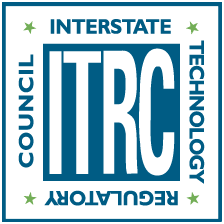
- AdsorptionThe mechanism whereby ions or compounds within a liquid or gas adhere to a solid surface upon contact. The term also refers to a method of treating wastes in which activated carbon is used to remove organic compounds from wastewater.
- AFCEEAir Force Center for Engineering and the Environment AMA American Management Association
- AnionA negatively charged ion.
- Arithmetic meanThe sum of a collection of numbers divided by the number of numbers in the collection, commonly referred to as the “average”.
- BiocharA carbon-rich, porous solid synthesized by heating biomass, such as wood or manure, in a low-oxygen environment (pyrolysis).
- BiomaterialsMaterials derived from plants or animals created for use as sorption materials.
- CationA positively charged ion.
- CoagulationThe process of destabilizing a colloid or suspension that unbalances the forces that separate the particles, often by neutralizing the charges on the particles and allowing the particles to clump or settle.
- EBCTEmpty Bed Contact Time: A measure of the time during which water to be treated is in contact with the treatment medium in a contact vessel, assuming that all liquid passes through the vessel at the same velocity. EBCT is equal to the volume of the empty bed divided by the flow rate (Sacramento State University 2019).
- Electro precipitation/electrocoagulationThe use of an electrical current to enhance the coagulation and precipitation of ionic compounds. The electrical current may attract the compounds to an anode or cathode, or create coagulating ions from a sacrificial anode, or both.
- Empty bed contact time (EBCT)A measure of the time during which water to be treated is in contact with the treatment medium in a contact vessel, assuming that all liquid passes through the vessel at the same velocity. EBCT is equal to the volume of the empty bed divided by the flow rate (Sacramento State University 2019).
- FlocculationA process in which the suspended particles of a destabilized colloid or suspension form groups or clumps (known as a “floc”). Coagulation and flocculation work together to separate solids and liquids containing colloids and suspensions.
- Fluorotelomer substanceA polyfluoroalkyl substance produced by the telomerization process.
- Geometric meanThe central tendency or typical value of a set of numbers, derived by multiplying the numbers in a set then finding the nth root of the product, where “n” is the number of values in the set.
- HeadThe part of a molecule that is a charged functional group attached at one end of the carbon chain tail.
- IncinerationThermal destruction process typically characterized by oxidation at temperatures in excess of 1,000°C.
- IsomersChemicals with the same chemical formula, but different molecular structures.
- Membrane fouling
- MicellesParticles in which long hydrocarbon tails, repelled by the water molecules and attracted to each other, make up the interior, whereas the negatively charged heads coat the surface and interact with the surrounding water molecules and positive ions (Ege 1999).
- Mineralization/decomposition/destructionThe breakdown of a chemical compound into its constituent elements and carbon dioxide and water.
- MoietyA specific group of atoms within a molecule that is responsible for characteristic chemical reactions of that molecule (Helmenstine 2019).
- OrganoclaysA naturally occurring clay mineral that is organically modified to incorporate cations and enhance the sorption capability.
- Perfluorinated chemicalSubset of PFAS. Have carbon chain atoms that are totally fluorinated. Examples are perfluorooctanoate (PFOA) and perfluorooctane sulfonate (PFOS) (Buck et al. 2011).
- Perfluoroalkyl substanceFully fluorinated alkane (carbon chain) molecule. They have a chain (tail) of two or more carbons atoms with a charged functional group (head) attached at one end.
- PermeateThe water treated by a membrane filtration technology, which has passed through the membrane, and from which PFAS have been removed. The contaminants not passing the membrane accumulate in the filtrate, which also does not pass through the membrane.
- Polyfluorinated chemicalSubset of PFAS. Have at least one carbon chain atom that is not totally fluorinated (Buck et al. 2011).
- Polyfluoroalkyl substanceThe molecule has a nonfluorine atom (typically hydrogen or oxygen) attached to at least one, but not all, carbon atoms, while at least two or more of the remaining carbon atoms in the carbon chain tail are fully fluorinated.
- PolymerLarge molecules formed by combining many identical smaller molecules.
- ReactivationThe process of treating regenerated GAC to restore treatment properties.
- RedoxChemical reduction-oxidation processes and conditions that can result in the alteration of a chemical compound.
- RegenerationThe act of restoring some of the sorption capacity of a sorptive media (that is, activated carbon or ion exchange) by removing the adsorbed matter. For carbon, regeneration is a thermal oxidation process.
- sorptionRemoval of a compound from solution by solid phase constituents. This term is often used when the mechanism of removal (adsorption, absorption, or precipitation) is unknown. (Thompson and Goyne 2012)
- StabilizationA process to reduce mobility of compounds in the environment through physical or chemical means.
- SurfactantA surface-active agent that lowers the surface tension of a liquid.
- TailThe part of a molecule that is a chain of two or more carbon atoms.
- Thermal desorptionThermal treatment process intended to remove the contaminants from a solid medium (such as soil, sediment, carbon) and drive them into the vapor phase.
- ZwitterionAn ionic compound containing both positively and negatively charged groups with a net charge of zero.


